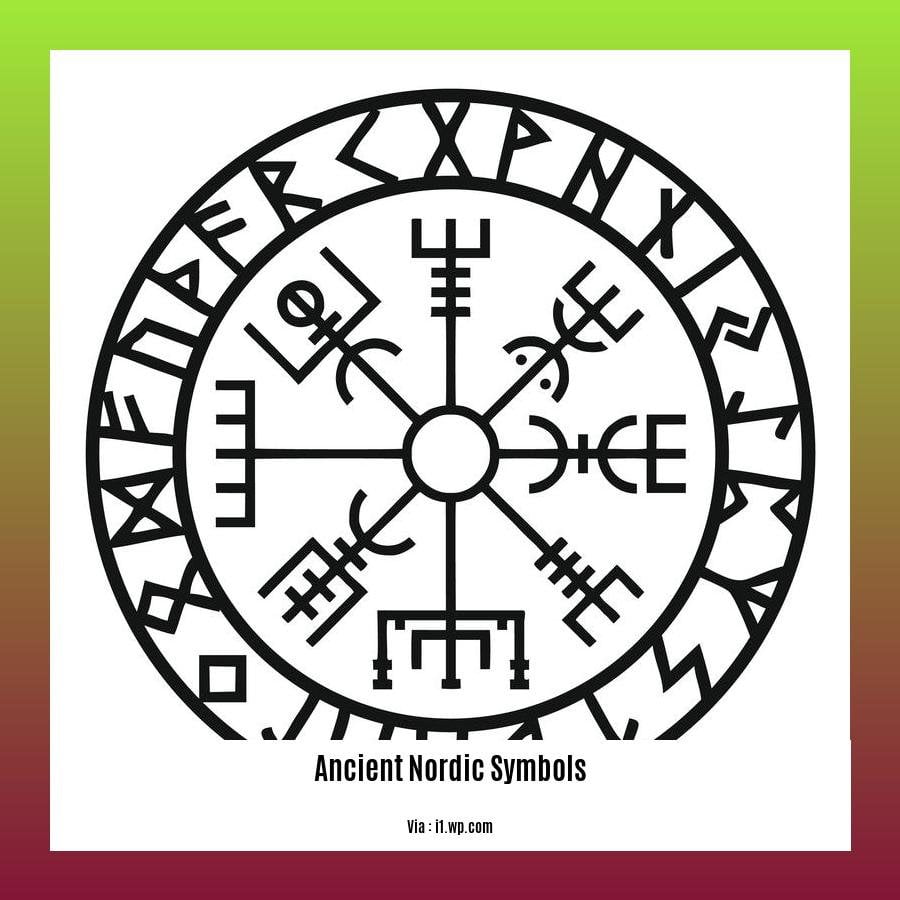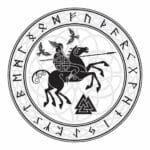Step into the fascinating world of ancient Nordic symbols, where each one holds a treasure chest of stories and deep meanings. These symbols, born from Norse mythology and the Viking era, give us a glimpse into the beliefs, morals, and spiritual ways of a people cloaked in legend. As we dive into the meanings behind the Valknut, Yggdrasil, Vegvisir, and Aegishjalmur, we’ll discover a tapestry woven together by the divine, nature, and the human soul. Join us on this journey to uncover the mysteries of these ancient treasures, exploring their roots, their meanings, and the echoes they still send through our minds.

Ancient Nordic Symbols
Let’s dive into the captivating world of Ancient Nordic symbols! These mystical emblems weren’t just pretty decorations for the Vikings; they held deep meaning and significance in their lives.
Valknut: Picture three interlocking triangles, almost like a Celtic knot. That’s the Valknut, closely tied to Odin, the king of the Norse gods. This powerful symbol embodies the weighty themes of death, sacrifice, and the honor found in facing them head-on. It’s a stark reminder that life and death are forever intertwined.
Yggdrasil: Imagine a colossal tree so immense, its branches hold up the entire cosmos! That’s Yggdrasil, the World Tree, a symbol of the never-ending cycle of life, death, and rebirth. This magnificent tree connects the Nine Worlds of Norse cosmology, reminding us that everything is interconnected in the grand scheme of things.
Aegishjalmr (Helm of Awe): This symbol is all about power and protection. Imagine eight fierce triangles interlocking to create a symbol that strikes fear into the hearts of enemies! This is the Aegishjalmr, believed to imbue warriors with courage and unwavering focus in the heat of battle. It’s like having a magical shield of bravery!
Vegvisir (Viking Compass): Lost at sea? Not these guys! The Vikings relied on the Vegvisir, a symbol resembling a compass with eight arms, each representing a direction. Each point also held a rune, adding an extra layer of mystical guidance for safe travels. Think of it as their ancient GPS, ensuring they always found their way.
Still Relevant Today! Even centuries later, these ancient Nordic symbols still captivate our imaginations. You’ll spot them everywhere–on jewelry, in artwork, even tattoos! It just goes to show the enduring power and fascination these symbols hold for us today.
- Uncover the intricate web of occupations in ancient Mesopotamia and delve into the specialized roles that shaped its society. Ancient Mesopotamia Job Specialization
- Journey back in time to discover the fascinating array of ancient names for soap, offering a glimpse into the diverse cleansing practices of the past. Ancient Names for Soap
- Explore the captivating world of ancient Norse symbols and uncover the profound meanings imbued within each intricate design. Ancient Norse Symbols and Meanings

The Meaning and Significance of Popular Norse Symbols
These symbols aren’t just cool designs; they’re like windows into the Viking soul. They tell stories about their beliefs, their history, and how they saw the world.
Key Takeaways:
- Norse symbols are deeply rooted in Norse mythology, embodying their beliefs and worldview.
- The Web of Wyrd symbolizes the interconnectedness of fate, woven by the Norns.
- The Valknut represents the cycle of life, death, and rebirth, associated with Odin.
- The Vegvisir, known as the Viking compass, signifies protection and guidance in perilous journeys.
Imagine a giant web stretching across time – that’s the Web of Wyrd. It’s woven by the Norns, three powerful women who control destiny. Every thread represents a choice, an event, a life. It shows how everything is connected, past, present, and future, all tangled up in this grand plan.
Then there’s the Valknut, three triangles all linked together. This one’s all about the circle of life, death, and rebirth. You’ll see it a lot with Odin, the god of wisdom and war. He actually sacrificed himself to learn the secrets of the runes, these magical symbols. So, the Valknut reminds us of the soul’s journey, going through life and beyond.
Now, Vikings were known for their ships, right? So, imagine how important the Vegvisir was to them. This symbol, with its eight points, was like their compass, their guide on dangerous voyages. Each point represented a direction, making sure sailors never lost their way. They believed it brought protection, too, like a lucky charm against the harsh seas.
Even today, we’re still drawn to these symbols. You see them on jewelry, art, even tattoos. They’re a tribute to the Vikings, their culture, and their strong connection to the gods. It’s like their stories live on, whispered through these powerful symbols.
How Did Vikings Use Symbols in Their Daily Lives?
Vikings didn’t just wear symbols, they lived with them. Imagine a world where a simple design on your necklace could show your beliefs to the world or a carving on your weapon could invoke the strength of a god. That’s how central symbols were to Viking life.
They wove these powerful emblems into their jewelry, stitched them onto clothing, and even etched them onto their weapons. These weren’t just fashion statements. A Viking’s bling wasn’t just about looking good, it was about showcasing their deepest hopes and beliefs.
Take Odin’s Mark, also known as the Valknut. This symbol, looking like three interlocking triangles, wasn’t just a cool design; it was a beacon of strength, a promise of protection, and even a symbol of the ability to travel between worlds.
Out at sea, where the Vikings were in their element, symbols became lifelines. The Vegvisir, with its eight spokes radiating from a central point, acted like a magical compass, guiding seafarers through unpredictable waters and dangerous journeys.
But these symbols weren’t just about personal beliefs or physical safety. They were storytellers. They brought to life the myths and legends of the Norse world, each image a chapter in epic tales of gods and goddesses, monsters and heroes. Think of them like snapshots of their beliefs, turning everyday objects into windows into their vibrant mythology.
Even the biggest moments in a Viking’s life were marked with symbols. Births, weddings, and funerals – all were imbued with the power of these visual stories, each symbol adding a layer of meaning to these pivotal events.
And if you think about Viking raids, they weren’t just about random groups of warriors. Symbols were their team emblems. They identified clans, shouted out tribal allegiances, and even acted as unique markers for individuals. Imagine them as intricate family crests, instantly connecting them to their community and heritage.
The Enduring Legacy of Ancient Nordic Symbols
These powerful emblems weren’t just decorative; they were woven into the very fabric of Norse life. Imagine a world where these symbols weren’t just pretty pictures but held deep meaning, reflecting beliefs about life, death, and the power of the natural world.
These weren’t static images, either; their meanings shifted and evolved over time, mirroring the changing beliefs and experiences of the Norse people. The Valknut, for instance, with its interlocking triangles, wasn’t just a cool design; it spoke to the cyclical nature of life, death, and rebirth. Then there’s the Aegishjalmr, a symbol of protection so powerful it was believed to make warriors invincible in battle.
Religion was a cornerstone of Norse life, and these symbols were central to their faith. They weren’t just abstract representations; each one brought to life a god, goddess, or mythical creature, connecting the Norse people to the divine realm. These symbols transcended religious rituals, though, becoming intertwined with their very identity, a visual reminder of who they were and where they came from.
Fast forward to today, and these ancient symbols haven’t faded into obscurity. They’re experiencing a resurgence, appearing on everything from jewelry and tattoos to modern art. For people of Nordic descent, these symbols are more than just trendy designs; they’re a tangible connection to their heritage, a source of pride and belonging.
- Star Ring Trends: Etsy vs Amazon - March 28, 2025
- Boost Pollinator Habitats: Baby Blue Eyes Sustainable Farming Guide - March 28, 2025
- Protect Big Black Bears: Effective Conservation Strategies - March 28, 2025
















